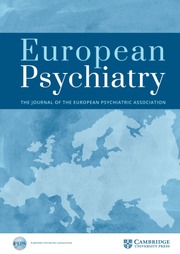Article contents
Myxœdema Madness: Case Report
Published online by Cambridge University Press: 15 April 2020
Abstract
Hypothyroidism is rarely associated with psychosis. This association has been reported since 1880 and described for the first time by Asher in 1949.
Case report: We report the case of a 60-year-old woman who presented at the age of 36 years a hyperthyroidism treated by benzylthiouracile, propranolol, and radioactive iodine. At the age of 49, she presented a hypothyroidism handled by a supplementation of thyroid hormones. The same year, she was admitted in psychiatric care for behavioral disorders, anorexia and insomnia. The diagnosis of hysteria was initially retained and the patient was lost sight of during 4 years. She was then re-hospitalized for psychomotor instability, delusions, insomnia, auditory and visual hallucinations, after she had stopped the treatment. Skin excoriations, caused by suspect cenesthetic hallucinations, were found in the examination. The diagnosis was chronic paranoid schizophrenia and the patient was treated with a long-acting antipsychotic associated to a supplementation of thyroid hormones. She was then lost from sight until 2014, when she was admitted for physical aggression, soliloquy, delusions of persecution auditory and visual hallucinations, and insomnia. The examination found significant dermal infiltration, a xerosis complicated with excoriations, a flushed face, macroglossia, hoarseness, difficulty in breathing and bradycardia . The biology revealed a rate of TSH=45.76uui/ml and FT4 <1pmol/l . Thyroid hormones have then been gradually introduced. The evolution was favorable with the disappearance of psychotic and somatic symptoms.
Though hypothyroidism is usually associated to a depressive symptomatology, it may, as shown by this case, be associated to psychotic symptoms.
- Type
- Article: 1869
- Information
- European Psychiatry , Volume 30 , Issue S1: Abstracts of the 23rd European Congress of Psychiatry , March 2015 , pp. 1
- Copyright
- Copyright © European Psychiatric Association 2015
- 1
- Cited by



Comments
No Comments have been published for this article.